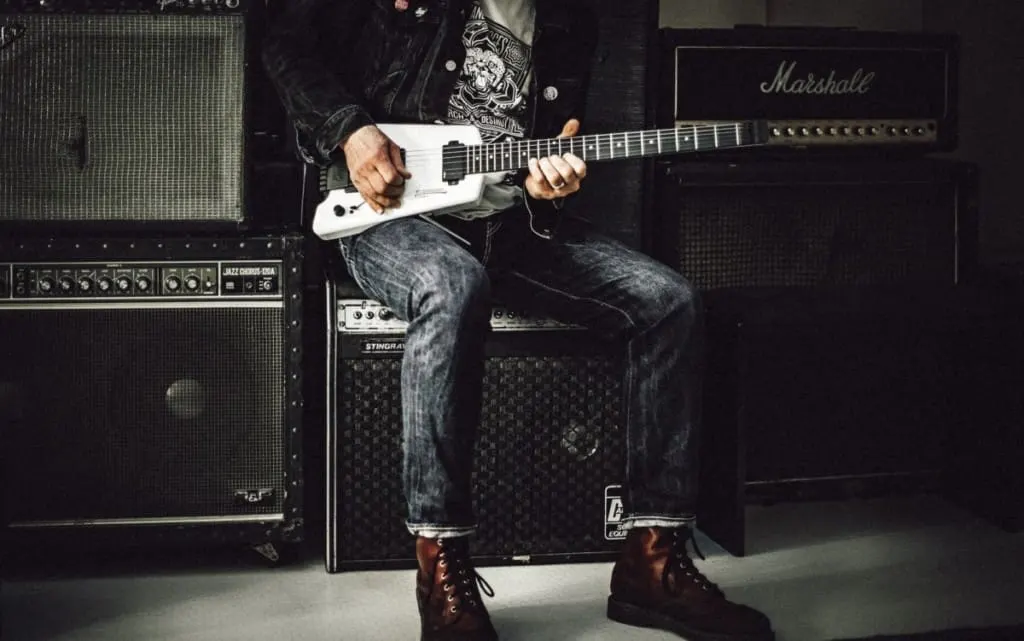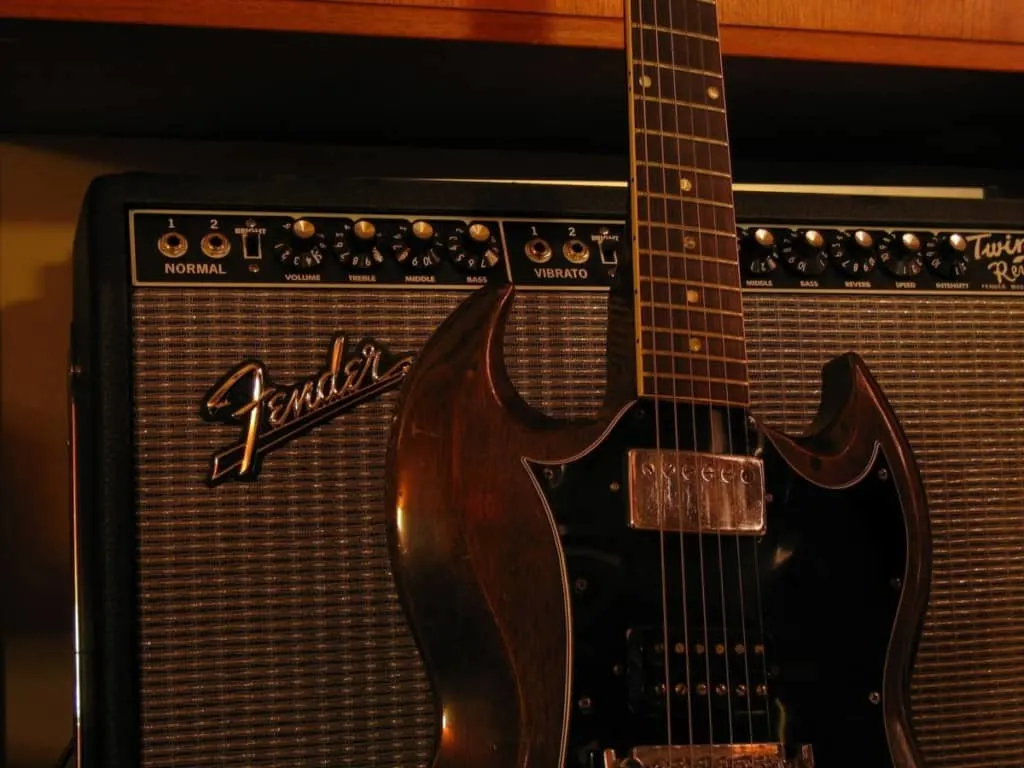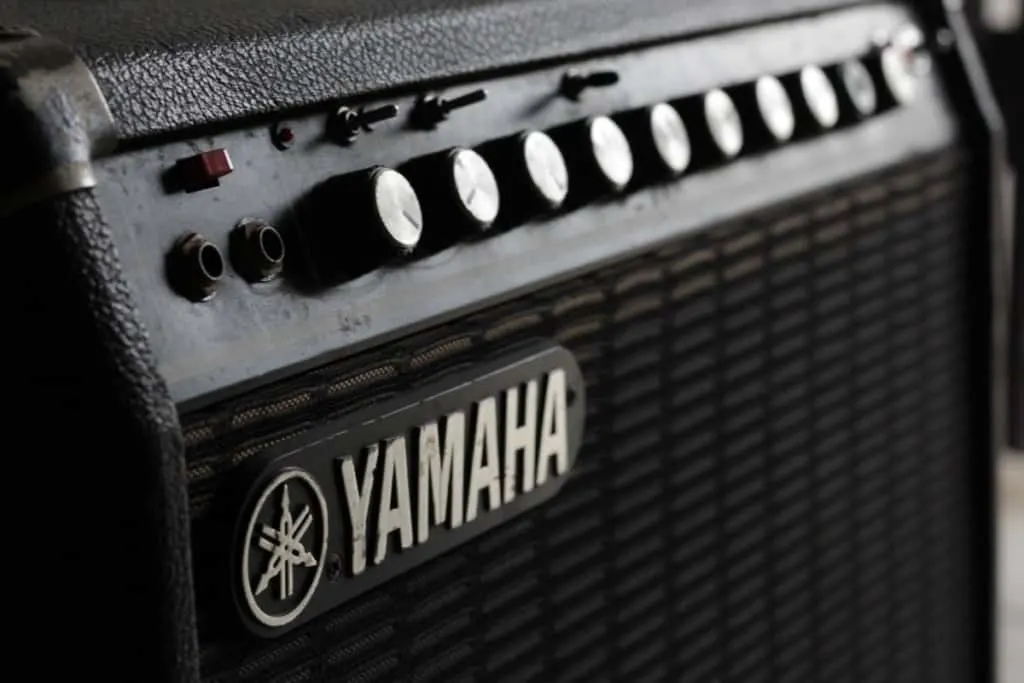You’re running late, get to the gig half an hour after what you planned and there is only a guitar amp sitting on the stage with some PA and the sound guy.
You have to rush to put it all together; your keyboard, guitar, loop pedal, and more.
You rush through it and go straight into the amp, all EQs at noon and you have fifteen minutes left to warm up those vocal chords before you hit the stage.
Time has come, lights go on and you hit that amazing major chord on your piano to make everyone happy starting that first song and suddenly, the guitar amp is distorting and sounding really bad with your piano gear and drum machine.
This is a very common scenario all of us musicians get to experience a lot. The whole truth about keyboard amplifiers and why multi-instrumentalists need them is what comes next.
So, what’s the difference between Guitar And Keyboard Amplifiers?
The difference between a guitar and keyboard amplifier is a combination of frequencies, inputs, speakers, features, and power. Although a keyboard can be plugged into a guitar amplifier a guitar amplifier isn’t designed to handle the frequencies and can often lead to damaged equipment.
Read on, learn, apply, and have a better-sounding live show starting today.

Introducing Keyboard Amplifiers
Most of us spend our entire lives playing live music and very rarely come across keyboard amps.
It is not that they are extravagant or precious; they are not super expensive either. They are mostly portable and great to work with. The key thing (not to be redundant) is that they are manufactured to accommodate the full spectrum of a grand piano which is up to seven octaves.
Very few instruments in music can go that far high and that far low; hence, the anatomy of a keyboard amp is as unique as it is non-special.
You can forget about valves and distortion since keyboard amps are closer to bass amps than to guitar amps.
What people really want with them is to have the biggest clean headroom possible. It is not that they don’t take or add effects well, it is just that pianists and synth players around the world do not focus so much in the mid-range and explore a little more in other areas.
Here’s a great video that explains amplifier headroom.
Also, with the proliferation of synths capable of reproducing any given instrument, there are high chances that keyboard amps will have to reproduce all sorts of sounds besides the grand piano, Hammond organ, and such.
Although it’s sometimes a common practice in the studio (something I do a lot) for funk, RnB, soul, and blues, it doesn’t work as well on stage.
I put Fender Rhodes, Hammond organs (or their low-budget equivalents), and some synthesizers of no more than 49 keys through an overdriven guitar amp such as a twin and capture the warmth of the tube which sounds distortedly amazing.
Despite being a common studio trick, for live performances when you have to go back and forth from a clean, pristine sound and an overdriven growl, you definitely need to have a clean amp.
Guitar Amplifier Overview
On the other hand, we have guitar amps.
These are not only very specific, they also came a long way perfecting little components one at a time. Technology has played a major role in electric and acoustic guitar playing and guitar amps now are more specific than they have ever been.
Guitar amps tend to have less headroom and distort (in a beautiful way or not) either naturally from the valves in the circuit or artificially emulating that valve overheating.
Guitar players are so focused on the mid-range that it is great to work in the studio with them.
The recording process of guitar amplifiers works as silk because the frequency spectrum is not only defined but incredibly focused and hence, nothing sounds like it and you can find a great place in the mix for it.
- Guitar amps are so specific that they can ruin a keyboard player’s night in a heartbeat making piano sounds like it is underwater.
Differences Between Guitar And Keyboard Amps
Now that we have defined each, it is time to talk about the differences between them. They are very different in many aspects except aesthetics, which is the main reason why many club owners and pub owners end up making the mistake of buying a guitar amp to accommodate all acts.

Guitar Vs Keyboard Amplifiers Different Frequency Range
This is the main difference in my opinion because it changes all of the below characteristics as well.
As I said before the number of octaves on the piano goes such a long way that a keyboard amp has to be able to accommodate bass-like lows and violin-like highs. Lows can’t be muddy and highs can’t be shrill.
Most keyboard amps work with onboard EQ to help you tame the sounds but the crucial part is how the preamp is voiced.
Preamps are like “the voice” of amplifiers, it is where the sound is processed before being sent into the world amplified by the power amp section and through the speaker.
This voice can make you want to buy or not buy an amplifier.
In the case of keyboards, this voice is less present; they are made to be as neutral as possible. This way, being non-especial, they can take whatever you want to throw at them.
On the other hand, guitar amplifiers have a distinctive voice depending on the brand which is what makes you prefer, for example, Fender over Marshall, Marshall over VOX, or VOX over Orange.
Guitar Amp Vs Keyboard Amp Features
This is another very distinct set of characteristics for each of these amps; let’s take a look:
· Line out – It is very rare to see a guitar amplifier with a “line out” XLR connection to go straight to the mixing board. It is much more common to see engineers do it old school and put a microphone in front of it. Well, keyboard and bass amps usually have this kind of line out that goes to the board straight out of the preamp. Some models have a “mute” switch next to it in case you want the speaker to be silent. For example, if you play a lot in events and you have good monitoring, you can just mute the whole thing and avoid making more noises than you should.
· Several inputs – Most keyboard amplifiers have more than one input. Why? You might ask yourself. Well, because most keyboard players have more than one keyboard running at the same time. When each channel has a separate volume and EQ you can easily accommodate your grand piano and your synthesizer to work together. On the other hand, guitar and bass amps only feature one input at the time. You should have to have several arms to play more than one string instrument at the time, right?
· Two channels – What most guitar amps have instead of several inputs are two channels. Usually, they are distorted/clean. The clean channel, though, is voiced and ready to break up musically and give us guitar players that marvelous overdrive we want. In the case of keyboard amps, you don’t need or want any distortion on them usually, so it becomes a single-channel, multiple input amp.
· Tilted-back shape – Most keyboard amplifiers are built to be used as a stage reference and hence have a tilted-back shape so you can have the speaker facing you. There are some acoustic guitar amps (the closest you can get to a keyboard amp in gear land) and bass amps that mimic the same shape but I would say it is something that it is almost exclusive to keyboard amps.
· On-board effects – Digital technology has come a long way and hence the addition of digital effects to the preamp of most amplifiers is a fact. On guitar amps, you get mostly two effects: reverb and distortion. On keyboard amps, this usually expands to a full-on DSP engine working in stereo like the Roland KC-220.

Tone Difference Between Guitar And Keyboard Amplifiers
Since the keyboard amp has so much sonic ground to cover, it is really difficult to make out which is the “tone” of the amplifier.
For example, Marshall amps are known for creating the “brown sound” which was characteristic of an entire era of music. Well, that doesn’t exist in keyboard amps.
They excel at being non-specific and hence the tone in them is quite flat. Of course, you can use the EQ to tailor your sound the way you like it but there is no specific tonal reference to work on or from. This makes the tonal palette of keyboard amps superb for using it with keys and other instruments.
Focusing on a frequency range equals losing in keyboard amps. Nowadays you can use most of these keyboard amps which are battery operated as a multifunction mini PA system where you can plug in your voice and maybe a drum machine as well as your keyboard.
Keyboard amps not only don’t focus on a frequency range but don’t focus on any instrument either. You can take the aforementioned Roland KC-220 and go out to play in a park with a full battery and three channels for your instruments.
Amplifier Speakers
Much of the resulting audio of an amplifier is defined in the speakers choice.
Usually, you can compare keyboard amplifiers to bass amps more than guitar amps in this regard. What most manufacturers do is to use 6.5”, 8”, 10”, and 15” speakers avoiding the mid-frequency filled 12” which is mostly the Holy Grail for guitar players in the world.
To this woofer that can be one or two in the sizes I said above, companies add a tweeter to cope with the highest frequencies the woofer can’t handle.
In some cases, woofers are two-way speakers and with the addition of the tweeter, you have a full-on 3-way speaker that covers the entire frequency range as if it was a PA hanging from a stadium. The speaker choice is not random and if you would play through a 12” speaker, mids would flood the mix without a shadow of a doubt.
Top 5 Keyboard Amplifiers For Live Performances
Here’s a quick guide to 5 excellent choices for live amplification of keyboards. These are either amps I own or have previously owned and used.
Take a look at these great amps on Amazon.
Guitar Vs Keyboard Amplifier Power Differences
In this regard, keyboard amplifiers are also closer to bass amps than guitar amps.
They always have way more wattage power than traditional guitar amplifiers. For example, if you want to have enough volume for a mid-size stage and go for a mid-size keyboard amp you’ll be looking at 200 watts whereas in guitar amplifiers getting past 100 watts is very rare.
This response to the frequency range because guitar amps are so unique they don’t have to compete against almost any other instrument in that frequency range while the keyboard and bass amps compete even with drums.
The bottom line is that if you are playing with a guitar player who has a 100-watt amp, you should be using an amp that is at least twice that power.
Take a look at this video that shows various options for amplifying keyboards, synths, and digital pianos.
Portability Of Keyboard And Guitar Amplifiers
Keyboard amps have become more portable with time. They work as miniature PA systems.
It only takes a walk in a park to understand just how portable music gear has become. You can kiss goodbye to all the gas-driven electrical powering equipment because most of these amps made to play live with several inputs and a tweeter (usually an XLR input for vocals as well) have an internal battery.
You can just plug them at home, fully charge them, and face the world with your songs five days a week. Also, the tilt-back shape many of them have makes it easier for people walking around to hear the music you are making than if the amp was on solid ground just facing at people’s feet.
Alternatives Amplifiers
We’ve been through guitar amps, keyboard amps, what’s the difference and now it is time to look at the alternatives you could go for in case no keyboard amp is available.
Acoustic Guitar Amplifiers
Acoustic guitars don’t go as low as a piano goes but do have those high frequencies that require a tweeter.
Thus, the anatomy of these amps is very similar to that of keyboard amps. They usually have more than one channel with different EQ, volume, and assignable effects. For example, Roland, the same company behind the KC line of keyboard amplifiers has the AC line for acoustic guitars, and the resemblance between the lines is amazing.
You should be careful, though, because they are usually quite small and not manufactured to reproduce the low lows; I would say use them but don’t push them.
Active Speakers
This is another great alternative to keyboard amps: active speakers.
There are many, many PA audio brands out there manufacturing small, portable 10”, 12”, and 15” speakers with three inputs, battery-operated (or not) that are even Bluetooth compatible. These speakers have an internal frequency divider and can take almost anything you throw at them from Enya to Nirvana.
Can You Plug An Electric Guitar Into A Keyboard Amp?
The answer to this question is an absolute yes.
The frequencies that an electric guitar is capable of aren’t more than what the keyboard amp can reproduce and hence there is no hazard in doing this.
What I can tell you is that it is boring to do it. Buying a keyboard amp to play guitar through is like buying a Ferrari to commute to work through city traffic daily. You can make so much more with a guitar through a guitar amp and it will sound so much better.
Can You Plug A Keyboard Into A Guitar Amp?
Now, here is where it gets a little tricky.
If it is an acoustic guitar amp you can do it being careful. If it is a regular guitar amp and we are talking about a full-on seven-octave piano, then the answer is very different because you can literally blow the amp and the speakers pushing it to reproduce frequencies it can’t.
If you plug a synthesizer to a Marshall 4×12 speaker cabinet with a 100-watt valve head on top it is going to be a tough one to break but if it is a smaller amp with, let’s say, on 12” speaker and 50 watts of power you can do some serious damage to it.
Looping For Multi-Instrumentalists
Guitar amps and keyboard amps both can help multi-instrumentalists who work their way around looping several different instruments including vocals.
The key here is to be wise in how to make your connections.
Playing everything through a guitar amp will not only sound too focused on the mids like if you were underwater but also the sustained practice of playing through that guitar amp might eventually blow up the speaker cone or even the amplifier itself.
You can check this cool video in which a multi-instrumentalist who bought a guitar amp by mistake lets you hear the difference between a Roland keyboard amp and a Marshall guitar amp.
Final words
Guitar amps are very specific pieces of equipment that have a very short action range in which they perform superbly. On the other hand, keyboard amps are very non-specific and can accommodate most instruments reproducing the entire tonal range they can produce faithfully and noise-free.
That is not the only answer to the question about what’s the difference between guitar and keyboard amplifiers; we also have dedicated speakers (adding a tweeter too), DSP modeling effects, multiple inputs, and even battery operation.
Guitar amplifiers and keyboard amplifiers are created differently and that difference is what makes them excel in their own field. If you are a keyboard player you owe it to yourself to try your instrument through one of these and hear the difference.
Happy (full tonal range) playing!
